If you want to track and understand the returns from your content marketing campaigns, you must know how to measure the content marketing ROI. Content marketing is useful only if it generates a substantial ROI. Otherwise, your efforts would be a waste. In this blog, we will cover the different metrics which are used to understand content marketing and the goals you can achieve with them.
What is Content Marketing ROI?
Content marketing ROI shows the percentage of revenue you generate from your marketing efforts compared to the costs incurred. ROI is not necessarily an immediate result. To understand the content marketing ROI, you must prioritise the metrics which you will use to measure it.
Key Content Marketing Metrics
There are different metrics for measuring content marketing return on investment. Some common metrics are:
- Organic Traffic
Organic traffic shows the number of people who visit your website from unpaid search results. It indicates how effective your SEO is. You can use tools like Google Search Console to Semrush to track your organic traffic.
- Lead Generation
Effective content marketing campaigns help to generate leads in different ways. By creating a winning content marketing funnel business owners can convert more traffic that will help to increase sales. Thus, tracking leads also important for each piece of content.
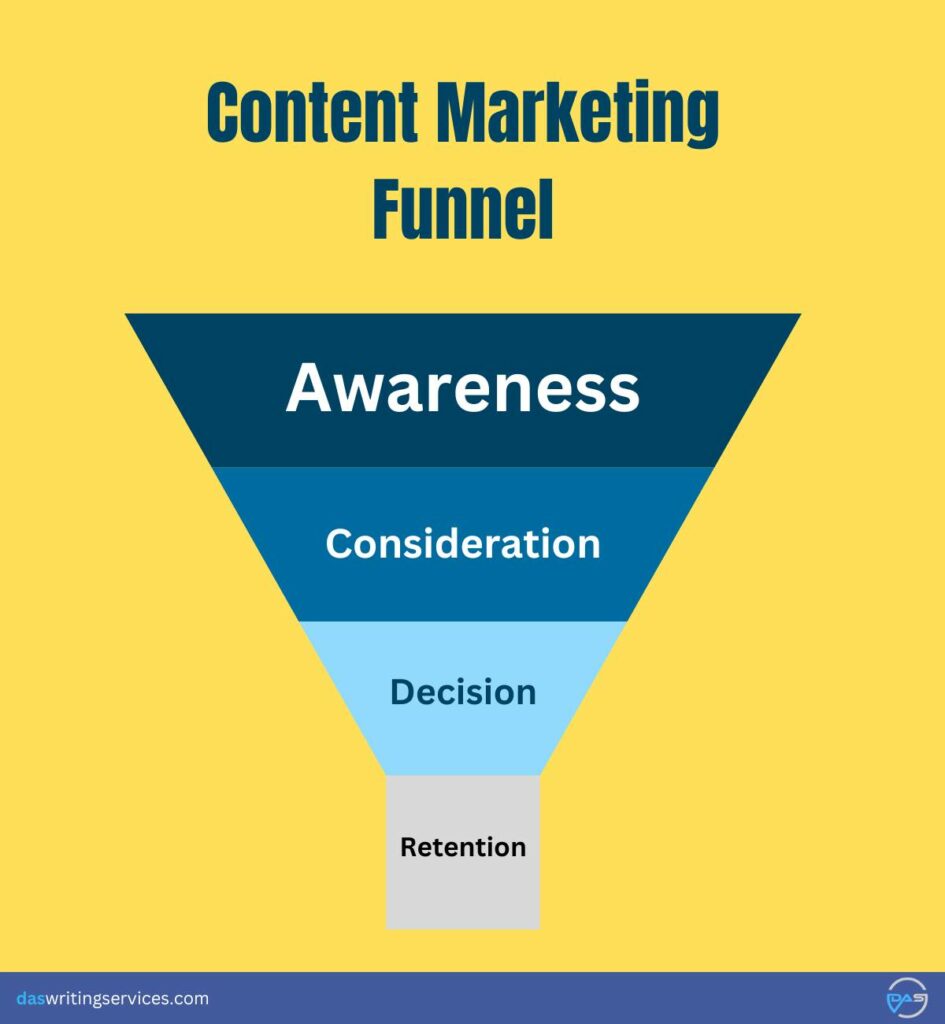
- Sales
Generating sales is the expected follow-up to lead generation. You can track the revenue generated, the growth in sales, and the weekly, daily, and monthly targets to understand how your content marketing efforts are building your sales.
- Sharing
Though shares do not generate direct revenue it is an important factor. This is because through sharing, your content will get more exposure among your target audience. So, it is better to track your content sharing to understand the reach of your content.
- E-mail Open Rate
Under this metric, you track the percentage of recipients who open your email. It reveals to you the effectiveness of your email campaigns. If your emails are informative, and well-written, and the subject lines are attention-catching, a greater percentage of the recipients will open the email.
- Click-Through Rate (CTR)
The CTR is the ratio of the number of people who click on a link to the number of people who see it. It shows whether your audience is attracted to your content and feels inclined to click on your ads, blog posts, links in emails etc.
- Bounce Rate
The bounce rate shows the percentage of people who leave your website after going through only 1 page. A high bounce rate is a cause of concern while a low one indicates that the audience finds your website engaging.
- Brand Mentions
Brand mentions cover the instances when your brand is mentioned across different platforms. A high number of brand mentions can boost your credibility and attract more traffic to your website.
- Backlinks
Backlinks are hyperlinks from external websites to the content on your website. Google judges the backlinks which a website has to judge its ranking on the Google Search Engine Results Page (SERP).
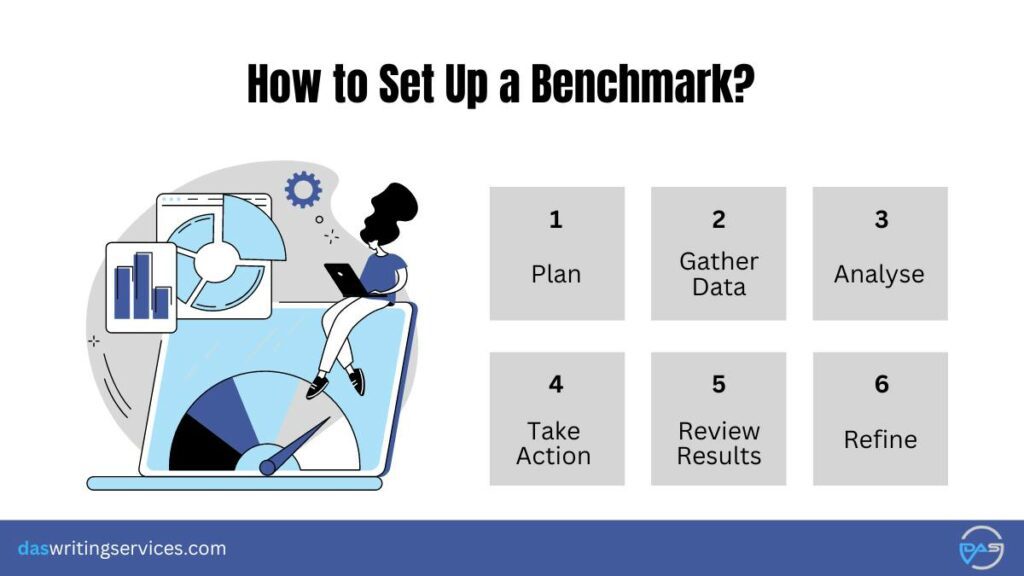
How to Measure Content Marketing ROI?
To calculate content marketing ROI you need to follow a few steps. These are as follows:
Step 1: Calculate Content Production and Distribution Cost
Firstly, you need to get the complete cost of your content production and distribution by analyzing different aspects. These aspects include:
- The payout of the content creator or writer
- Image, video, and audio production cost
- Cost of outsourcing
- Other costs
In-house content production and other external costs should also be considered to get a complete calculation.
As you find the content production cost, now it is time to move to content distribution cost. Content distribution or content marketing costs differently. For this, there are several other factors such as
- Pay-per-click advertisement costs
- content creation software and tools
- Posting on different paid platforms
- Social advertisement costs
After merging content production and distribution costs you can get the full amount that is your total investment for content marketing.
Step 2: Get the Output
As you have a clear idea of your content creation cost, now is the time to calculate the sales. For this, you must analyze every piece of content and find out how many people have been converted through that.
You must accumulate add all the sales and conversions and get the total amount of revenue.
Step 3: Content Marketing ROI Calculation
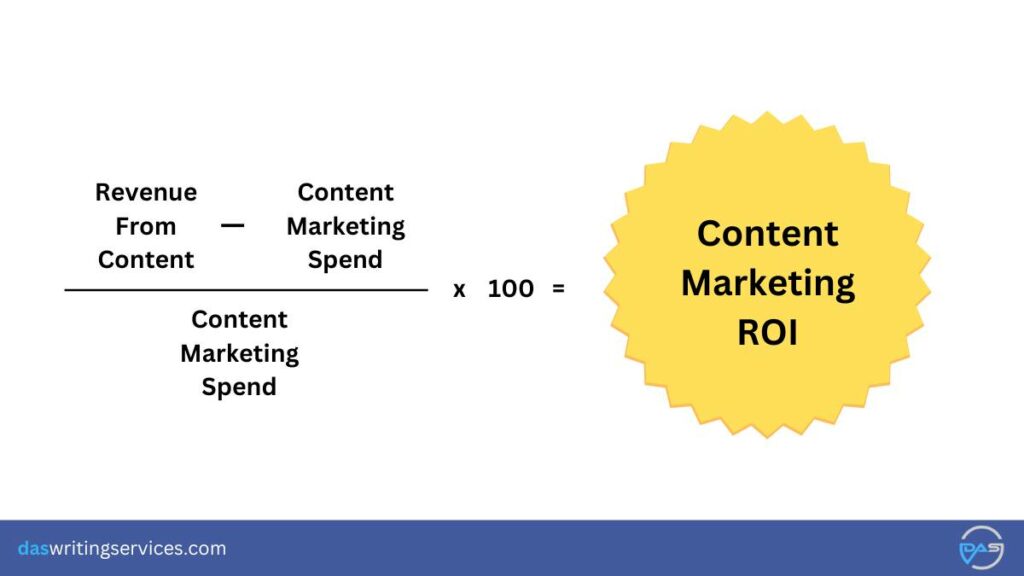
By now you have all the numerical data that you need to put into the content marketing ROI calculation formula. The formula is:
Content Marketing ROI = ( Return – Investment ) / Investment X 100
Check out the following example to understand how this formula works:
Suppose you have invested ₹1000 for content marketing and received a return of ₹5000. Then your content marketing ROI will be
{(₹5000 – ₹1000)/ ₹1000} x 100 = 400%
You can also use a content marketing ROI calculator to calculate the ROI. For this, you need to enter relevant data such as the cost of creating your marketing content, the time span over which it was spent, the number of people who visit different types of content, and the lifetime value of a customer.
Please note that the functioning of such calculators varies across websites. You must understand the metrics which a calculator is using to calculate the ROI.
How to Increase Your Content Marketing ROI?
To get better ROI, business owners must create better content. Here are a few tips to increase your content marketing ROI:
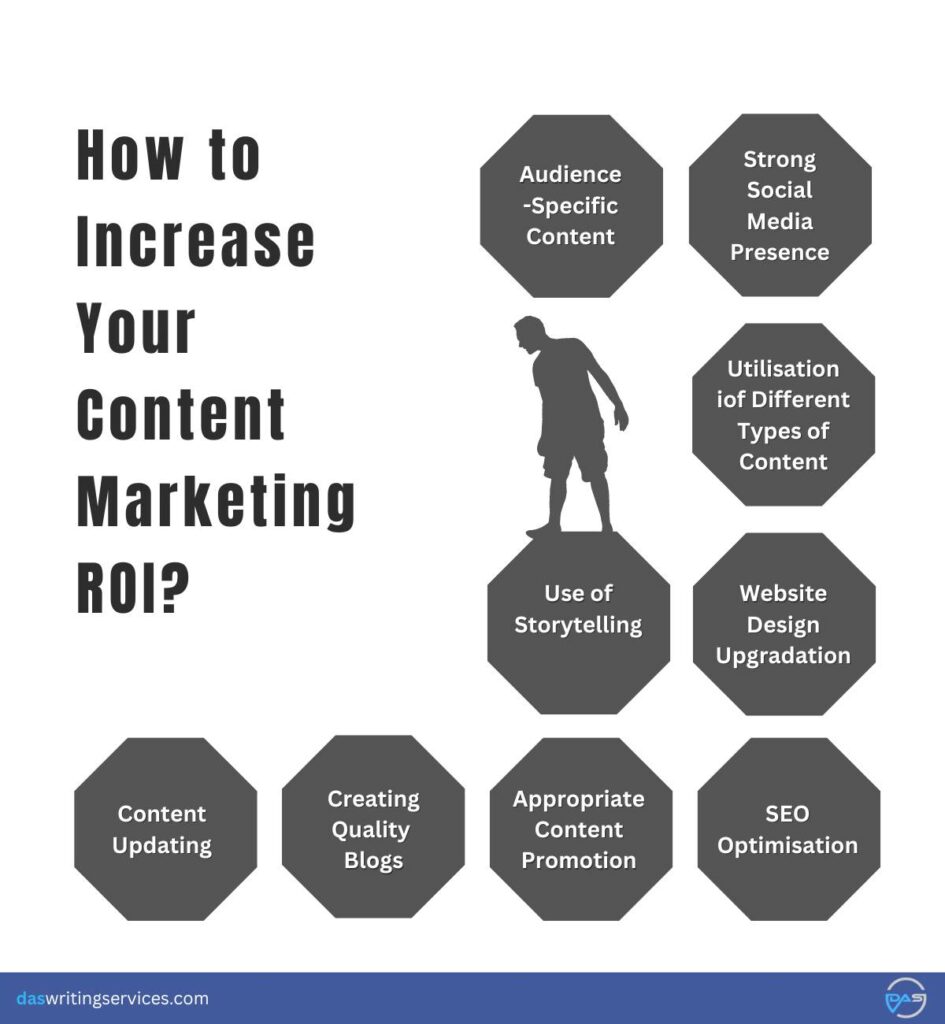
1. Audience-Specific Content
The audience is the main focus for creating revenue-generating content. As it is about making them satisfied you need to research and find what your audiences want to read or see. To find out what the audiences want you can:
- Analyze your web traffic.
- Ask your audience what type of content they want to see through social media polls and questionnaire sessions.
- Consider the conversations of your audience on different platforms.
- Find out which types of information are high in demand yet your audience can’t access them. Create content regarding that information.
- You should consider audience feedback as well.
2. Strong Social Media Presence
Social media platforms are really important nowadays to gain huge followers who are also potential customers. It is also a great place for marketing different types of content. However, for this business owners must have a strong social media presence. Some suggestions to become popular on social media are:
- Posting regularly on social media platforms
- Making people engaged through different campaigns
- Sharing website updates with your network
- Connecting with industry leaders
3. Utilizing Different Types of Content
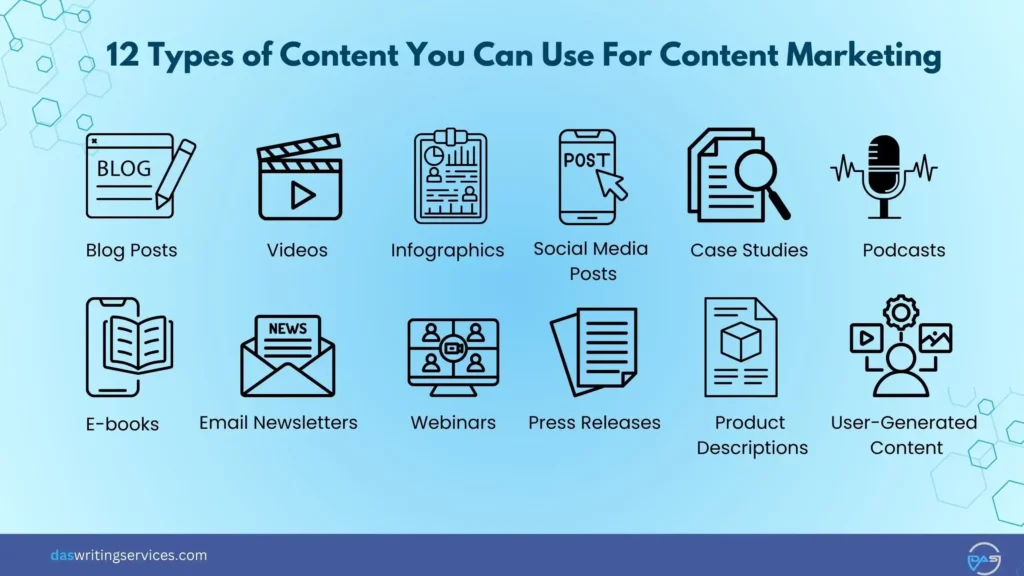
Apart from written content like blogs, articles, and technical content, there are several other types as well. Business owners need to deploy them as per their audience’s requirements.
For example, video content can be extremely engaging and attractive. A 2020 research by Wyzowl shows B2B businesses get 87% growth with video marketing. Nowadays, short videos are also very popular on different platforms. So, business owners can use videos to convey their offerings uniquely to their audiences. Some other types of content marketing are:
- Audio content creation
- Checklists
- How-to guides
- User-generated content
- Webinars
4. Storytelling in Content Marketing
Storytelling can give your content marketing a new dimension. When it is about creating a hook brand stories can be a game-changer as they provide interesting insights about the brand. Different beneficial aspects of storytelling are:
- Storytelling can humanize a brand
- It helps to connect with audiences’ emotion
- It can promote the brand value
- Storytelling adds extra charm to the content
5. Website Upgradation
Updating your website is important to get more impressions. When updating a website some common traits you should keep in mind are:
- Your website should be easy to use
- Mobile-friendliness is a must
- Brand owners can change colours, themes, fonts, etc. to upgrade the look of the site
6. Content Update
Content update is a great step to enhance the SEO of your content. For example, after posting written content, one can revamp that by removing outdated information and adding new ones. Content upgradation can help in several ways such as:
- It highlights the purpose
- It helps to insert feedback from your audiences in the content
- Content upgradation helps to fill the gaps in the content publishing chain
- Content upgradation adds more value to content
While updating may help you in most cases to stay relevant, it is also important that you remove outdated content from your website, which will serve value no more.
7. Blogs are Must
Blogging can also help to boost content marketing ROI effectively. Companies that post high-quality blogs definitely earn more traffic. Thus, website owners should invest a certain amount of time in creating excellent blogs. While creating blogs to increase your marketing ROI, one should consider aspects such as:
- Making attractive headline in the blog so it gets more clicks
- Paragraph length should be short, and sentences should be crisp
- The approach should be creative and unique
- Blogs should be authoritative and reliable
8. Content Promotion Should be Apt
Proper content promotion is necessary to get a better marketing ROI. There are multiple places where you can promote your content and get better responses. However, you need to utilize them tactfully in your favour. Some popular ways of content promotion are as follows:
- Doing effective e-mail marketing
- Attractive social sharing
- Paid promotion
- Influencer marketing
- Posting content on high-authoritative sites
9. Content Marketing ROI and SEO Optimization
SEO optimization is the important for boosting content marketing ROI. The simple logic is the more your content will be visible on SERP, the more traffic you will get. A great volume of traffic is necessary for more potential leads and better conversion. Strong SEO can help to:
- Rank on the featured snippet
- Rank on target keywords
- Increase domain authority
- Rank on ‘people also ask section’
- Getting more valuable backlinks
Challenges Faced While Calculating Content Marketing ROI
Some challenging factors that you need to remember while calculating content marketing ROI are:
- Falling for Quick Returns
Quick returns are not always the best result for B2B content marketing ROI. After analyzing different metrics you can only understand the actual returns of your investment that can boost the growth of your business.
- Deploying Wrong KPIs
When doing content marketing you should focus on the relevant KPIs that can bring you more conversion. Targeting as many as possible is the wrong step.
- Overlooking Holistic Benefits
As mentioned earlier, ROI is not only about measuring monetary returns. Business owners must look forward to overall benefits as well. Often, content marketing does not elevate authority properly which is also a regulating factor. So, brand owners should properly check every aspect and find real benefits.
Key Take Aways
- Content marketing ROI calculation is important for every business owner
- It is the total return on the investment regarding content marketing
- There are key metrics to check content marketing ROI
- To get better ROI, brand owners should experiment with different types of content
- Focusing on the right keyword is extremely important
- Content promotion should be on point
- Paid promotion is also necessary along with organic reach
To conclude, you must understand the different content marketing metrics such as organic traffic to measure the content marketing ROI. Your main goal should be to create well-researched, good-quality content which is useful for the audience. It will improve your reputation and can potentially lead to more sales.
Frequently Asked Questions
1. What is a good ROI for social media content marketing?
The answer depends on your goals, the amount you have invested, and the strategies you used to maximise the content marketing ROI.
2. What is website traffic?
In simple words, website traffic is the total number of visitors that every site receives. Website traffic is also associated with tracking how much time visitors are spending on a site.
3. What is a must for better content marketing ROI?
For better content marketing ROI, being consistent in posting high-quality content is necessary. Along with that, promoting content properly on different platforms is also necessary.





Leave a comment